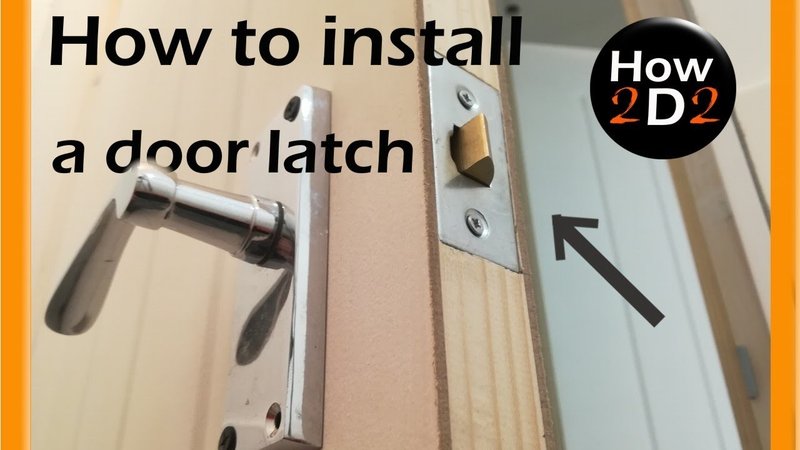
Imagine you’re inviting a friend over for coffee, and you want to share how to install this latch as easily as sharing a favorite recipe. The drive-in latch operates with a simple mechanism that keeps your door securely closed while allowing for effortless opening. Brands like Schlage or Kwikset offer quality options, and with a little guidance, you’ll be able to install one in no time. Let’s roll up those sleeves and get started!
What You’ll Need for the Installation
Before diving into the installation process, let’s gather everything you’ll need. Think of this as laying out your ingredients before cooking. You’ll want to have everything on hand to avoid interruptions.
- Drive-in latch kit: Choose a quality latch that fits your interior door.
- Drill: A reliable power drill will be your best friend here.
- Chisel: For creating the pocket for the latch to sit in.
- Screwdriver: A basic tool for securing the latch.
- Measuring tape: Precision is key, so have this handy.
- Pencil: To mark measurements and drill points.
Having all your tools ready will make the process go more smoothly. You don’t want to be halfway through and realize you’re missing a part or tool!
Step-By-Step: Removing the Old Latch
First, you’ll want to start by removing the old latch, if there is one. This is like prepping your canvas before painting. Follow these simple steps:
1. Unscrew the Existing Latch: Use your screwdriver to take out the screws holding the old latch in place. Keep these screws handy, as you might need some of them later.
2. Remove the Latch Mechanism: Once the screws are out, gently pull the latch from the door. Sometimes, it may stick a little; you can use the chisel to help pry it out.
3. Clean the Door Surface: After the latch is removed, take a moment to clean the area. This helps ensure the new latch sits snugly without any debris getting in the way.
Removing the old latch is straightforward, but if things feel stubborn, don’t force anything—just take your time.
Measuring and Marking the Spot for the New Latch
Now that the old latch is out, it’s time to install the new one. This step is crucial for ensuring the latch functions correctly. It’s like measuring ingredients for a new recipe—accuracy is important!
1. Determine the Center Point: Use your measuring tape to find the center of the door edge. Typically, a drive-in latch is placed about 36 inches from the floor.
2. Mark Where to Drill: Once you’ve found the center, mark it with your pencil. This guide will help you drill accurately.
3. Check Depth Requirements: Make sure the depth of the hole is compatible with your new latch. Most drive-in latches need a hole about 1 inch in diameter and a little over 2 inches deep.
Taking these measurements seriously will help prevent any misalignments and ensure a smooth installation.
Installing the Drive-In Latch
Alright, you’re almost there! Installing the drive-in latch is like locking in the flavors of your dish—it’s where everything comes together.
1. Drill the Hole: Use your drill to create the hole based on your measurements. This is where the latch will fit snugly.
2. Chisel the Pocket: If your latch requires a little space to fit perfectly, use the chisel to create a pocket in the door edge. Be gentle; you want a neat finish.
3. Insert the Latch Cylinder: Take your new latch and insert it into the hole. There shouldn’t be any wiggling—it should fit nice and tight.
4. Secure the Latch: Use the screws from your kit to secure the latch into place. Make sure it’s tightly fastened for functional use.
This step is where the magic happens. Once the latch is in place, you can almost hear your door saying “thank you”!
Testing the Latch Functionality
Now that your drive-in latch is installed, it’s time for the fun part—testing! Think of it as the moment you taste your newfound dish.
1. Close the Door: Gently close the door and make sure the latch engages smoothly. You don’t want any awkward sticking or resistance.
2. Open and Close: Open and close the door a few times. It should operate easily without needing to force it.
3. Adjust If Necessary: If it doesn’t feel right, you may need to make slight adjustments. Sometimes, a little tweaking can make all the difference.
Testing your new latch will give you peace of mind that it works perfectly. You’ll feel a sense of accomplishment knowing you tackled this project!
Troubleshooting Common Issues
Sometimes, things don’t go as smoothly as planned, and that’s completely normal. Here are some common issues you might encounter, along with tips to fix them.
1. Latch Doesn’t Catch: If the latch isn’t engaging, check the alignment. Sometimes it may need slight adjustments to fit perfectly.
2. Door Won’t Close Fully: This might mean the hole isn’t deep enough or the latch isn’t set properly. Reassess and make necessary changes.
3. Screws Keep Coming Loose: If the latch feels shaky, ensure you’re using the correct length of screws. Longer screws may provide more stability.
These troubleshooting tips will save you from frustration. Remember, every project is a learning opportunity!
Enjoying Your New Drive-In Latch
Congratulations on successfully installing your drive-in latch! Imagine how satisfying it is knowing you did this task all by yourself. Now, every time you open and close that door, you’ll appreciate the smooth functionality.
Not only does a well-installed latch add convenience to your daily routine, but it can also give your door a refreshed look. Consider it a mini-makeover for your interior space!
If you ever decide to tackle more home improvement projects, remember this experience. With a little patience and the right tools, you can make your home even more enjoyable. Happy DIY-ing!
